Auxiliaries consumption
The auxiliaries consumption is the energy used for managing the system. This may be fans, air conditioning, electronic devices, lights, or any other energy consumption which has to be deduced from the PV produced energy to be sold to the grid.
Auxiliaries losses in the simulation
The Auxiliaries consumption loss is defined in the "Detailed Losses" part. It is defined globally for the whole system.
It will be accounted in the simulation only when you check "Auxiliaries consumption defined".
This example (for a big system of 100 MW) shows:
During the day:
- there is a constant power loss of 72 kW, which will become active only when the system delivers more than 100 kW
- there is a consumption proportional to the system power delivery (e.g. adapting cooling device, evacuating the excess heat due to the inefficiency of the inverter), expressed in [W/kW]
Both contributions may be specified independently, they will be added.
During the night:
- The night consumption of the auxiliaries is fixed, 13 kW in this case.
This doesn't include the intrinsic night loss of the inverter, which is specified within the inverter's definitions, and leads to a specific loss of the inverter (named "IL_Night"), appearing only when it is significant (more than 0.01%).
The auxiliaries consumption loss - day and night - is accumulated in the variable named "Aux_Lss".
Auxiliaries in the Inverter's definition
Manufacturers have also the opportunity of defining an Auxiliary consumption parameter, which represents the necessary power for cooling the inverter (usually internal fans).
In the inverter this can be defined as a constant power with a threshold.
Use in the simulation
The auxiliary power loss specified within the inverter is not "automatically" taken into account in the simulation: it may be used as default input in this dialog, by checking the corresponding checkbox here..
NB: In some inverters, this internal consumption (internal fans) is included in the efficiency curve. In this case it should not be mentioned here, otherwise it would be accounted twice during the simulation.
